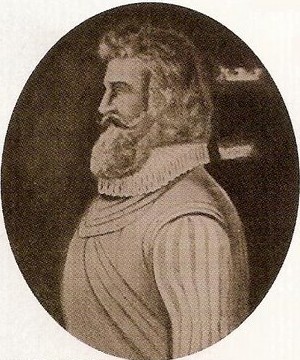Pedro Teixeira facts for kids
Quick facts for kids
Pedro Teixeira
|
|
|---|---|
 |
|
| Born | Late 16th century Cantanhede, Kingdom of Portugal
|
| Died | 4 July 1641 |
| Nationality | Portuguese |
| Occupation | Explorer |
| Known for | second European to travel up the entire length of the Amazon River, after Orellana |
Pedro Teixeira (died 4 July 1641) was a Portuguese explorer who became, in 1637, the first European to travel up the entire length of the Amazon River.
Teixeira was born at Cantanhede; the date of his birth is unknown. His exploits are considered remarkable even by today's standards. Because of Teixeira and other Portuguese who pushed into the depths of the Amazon, Portugal was able to obtain far more of South America from their Spanish competitors than the Treaty of Tordesillas had granted in 1494. Teixeira`s expedition became the first simultaneously to travel up and down the Amazon River. He was called by the Indian natives Curiua-Catu, meaning The Good and Friendly White Man.
1637: Amazon Expedition
In 1637, two Franciscan friars, under threats from nearby natives, abandoned their mission on the Amazon River and, with six soldiers, paddled a canoe up the entire length of the river to the principal Portuguese settlement of Fort Presépio (Belem). Their arrival led the Portuguese to wonder how far east the Spaniards had settled the Amazon. Although Spain and Portugal were both under the rule of Philip IV of Spain (Philip III of Portugal), trading rivalry was nevertheless intense and there was a strong movement towards the restoration of the Portuguese independence (which did take place in 1640). Consequently, the governor of Maranhão, Jácome Raimundo de Noronha, lost no time in commissioning an expedition under the command of Captain Pedro de Teixeira.
Teixeira already had considerable experience exploring the Amazon and the Xingu River leading expeditions to expel English and Dutch traders and settlers. One of the Franciscan friars, Andres de Toledo, was dispatched to Lisbon to report his expedition to the Portuguese authorities.
So Teixeira became the first European to travel up the Amazon River, reaching Quito by way of the Napo River. The Portuguese expedition was a large one, consisting of 47 canoes powered by 1,200 Native Amazonians and enslaved Africans to transport 70 fully armed Portuguese soldiers and their cargo of food, weapons, ammunition and barter goods. Feeding so many over a journey of several months was a formidable task, demanding the most of the explorers' hunting, fishing and food gathering skills, and often requiring barter with local tribes. The depth and breadth of forest and river knowledge of the Native Amazonians recruited for the expedition was essential for its final success. The journey upstream against a strong current was arduous, and advance parties were regularly sent out to reconnoiter the way ahead in order to identify the correct fork in the river to take. Teixeira also had difficulty persuading the Native Amazonians to stay with the expedition as it got farther away from their homes.
During the expedition, Pedro Teixeira explored the mouth of the Rio Negro and discovered the Madeira River, who explored in the downstream part and baptized with this name. The Madeira River and the Mamoré and Guaporé rivers linked to it would become decisive for the great journey of discovery conducted by António Raposo Tavares Flag from 1648 to 1652.
After eight months, the Portuguese-financed expedition reached the first Spanish settlement on the Rio Quijos. At this stage, Teixeira divided the expedition, sending eight canoes ahead while the remaining canoes stayed at the settlement for the return journey. The Rio Quijos was eventually abandoned when the current grew too strong, and the rest of the journey was completed on foot. After almost one year, in 1638, the expedition reached Quito to a rousing reception.
1638: Return Journey
Although the Spaniards of Peru afforded the Portuguese explorers every hospitality, they were nevertheless concerned to know how far the Portuguese had settled the Amazon. Based on the Treaty of Tordesillas of 1494, and the strength of the expedition of Francisco de Orellana, the Spanish considered the Amazon theirs. Consequently, Teixeira and his party were detained several weeks in Quito whilst the Spanish authorities decided what to do. In the end it was decided to send a party of Jesuit priests, headed by Cristóbal de Acuña, to accompany the Portuguese on their return journey and report all they observed. Father Cristóbal was to present his report to the Royal Council of the Indies.
Father Cristobal's report was published as a book in 1641. In it, he gives a glowing account the Amazon regions and is especially complimentary towards the indigenous Brazilian natives and their way of life. The expedition itself appears to have been uneventful, apart from a disagreement between the Jesuits and the Portuguese officers over a proposed slaving expedition up the Rio Negro. Teixeira gave way to the Jesuits over the slaving issue and the expedition eventually reached Belém on 12 December 1639, just over two years after it had set out. Although Father Cristóbal urged Spain to lose no time in settling the Amazon, his advice came too late. In 1640, King João IV was proclaimed king of Portugal and, in 1641, the Portuguese of the colony of Brazil also recognized him as such.
Little is known about Pedro Teixeira apart from the Amazon expedition. After completing the expedition he went to São Luís do Maranhão to make his report to the governor. He was duly promoted to Capitão-Mor. He accepted the post of governor of Pará on 28 February 1640 but he yielded the office after three months due to ill health. He died on 4 July 1641.
See also
 In Spanish: Pedro Teixeira (militar) para niños
In Spanish: Pedro Teixeira (militar) para niños

